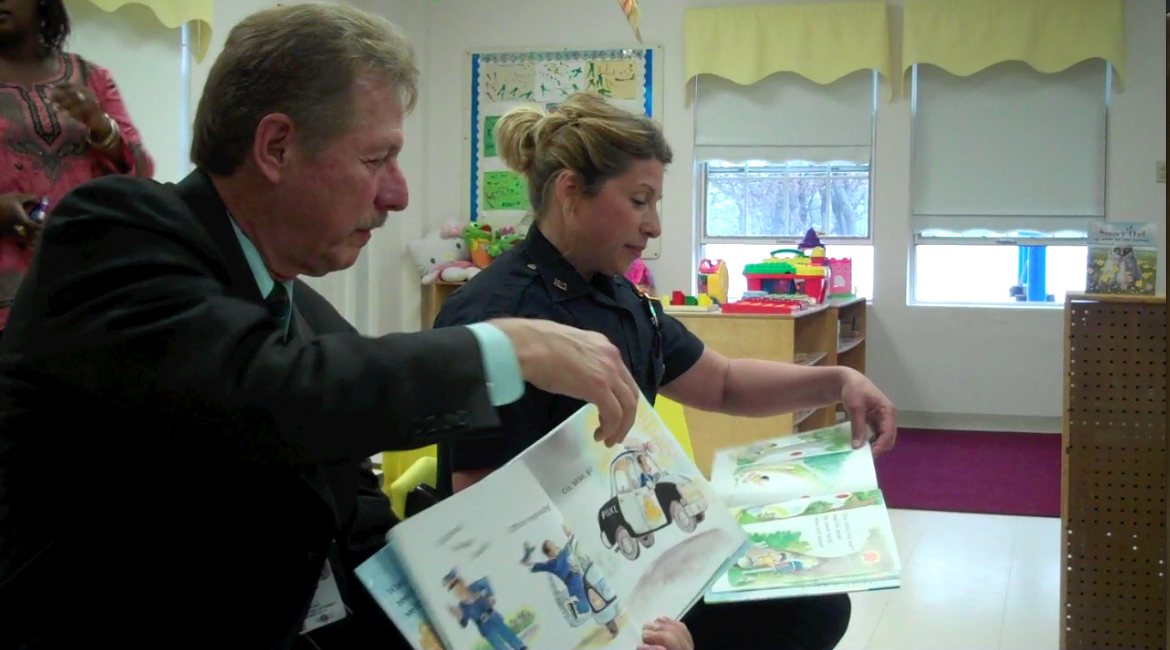

Nassau County Assistant District Attorney Rene P. Fiechter (left) and Suffolk County Police Officer Wendy Verlotte (right) reading children
Local law enforcement officials raided a Huntington school Thursday wielding an often overlooked crime-fighting tool they said should be used more often: childrens books.
Local police, prosecutors and politicians joined a nationwide nonprofit crime prevention organization at the Rainbow Chimes Early Childhood Education Center to discuss a new study that urges New York State to set standards for high-quality early education to decrease the likliehood of kids growing up to be crooks. And, in practicing what they preach, the group also read to the children.
“Half the battle in getting our handle on the crime problem in this nation is in prevention,” Meredith Wiley, the state director of Fight Crime: Invest in Kids, said while flanked by Nassau County Assistant District Attorney Rene P. Fiechter and Suffolk County Police Officer Wendy Verlotte.
The report, “Quality Matters: High-Quality Early Care and Education Can Cut Crime in New York,” makes the case for a program called QUALITYstarsNY—an initiative that would create a uniform standard curriculum and programs across the state for all early learning settings.
Wiley said the initiative has been field tested in 230 sites and 13 counties in New York State. She cited 40 to 50 years of research that says high quality learning “really sets up children to succeed in school and have better life outcomes.”
Seventy percent of people in jails and prisons don’t have a high school education or diploma, she said, as a teacher was talking to preschoolers in a nearby room. “We know that there’s a very strong link between school success and crime, and crime prevention.”
The report includes two studies by separate institutions. The Michigan’s Perry Preschool study found “at-risk children who did not participate in the high-quality program were five times more likely to be chronic offenders by age 27 than children who did attend.”
At-risk children left out of Chicago’s Child-Parent Centers were 70 percent more likely to be arrested for a violent crime by the age of 18, according to another study published in the Journal of the American Medical Association.
“We’re really hoping that our legislature, our governor, our local decision maker, county executive, the county boards … will really look at QUALITYstars,” Wiley said.
After discussing the report, Allan Kasof, the school delegate director, took the group to the “yellow room” where a group of three year olds were playing in the colorful classroom decorated with posters, books and art work.
Officer Wendy Verlotte, who focuses on community outreach in the PoliceSmart program to talk to students from K to 12, sat in a small yellow chair in front of an even smaller table, and picked up the book “Police Officers on Patrol.”
With a dozen children sitting attentively on a blue carpet, she enthusiastically read the book to the children, many of whom said they want to be a police officer when they grow up.
“Uniform, badge, radio, police officers getting ready to go,” Verlotte read out loud, with Fiechter at her side showing the children pictures from the book. “People need help,” she said to the smiling kids, “let’s Rock N’ Roll.”
When one of the kids mentioned seeing Verlotte’s gun she was quick to tell them that it was a “tool” very much like the tools the character Bob the Builder—a cartoon character—carries around when he has to fix something that’s broken.
“These are things they understand,” she said after having laughs with the kids. “They can then fixate on the usefulness of that tool, as opposed to the fact that this is a weapon and it’s something to be in fear of.”
Verlotte, who is a former high school teacher said “it’s unlike any other feeling,” going into schools and talking to students. “It’s the most rewarding thing that you can do, to have that interpersonal reaction, and experience with kids.”
“I think it definitely helps them,” said Heather Rugile, a lead instructor at the school. “They talk about firefighters, policeman, and learning to dial 911, but seeing a person, and actually seeing a police officer and associating that with what they learn, and what they know, and what they read about, is entirely different.”






